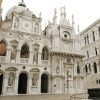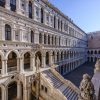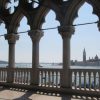The Courtyard. Having entered the palace by the Porta del Frumento, the oldest side of the building, you can see the Piazzetta wing to the left and the Renaissance wing to the right. The north side of the courtyard is closed by the junction between the Palace and St. Mark’s Basilica, which used to be the Doge’s chapel. At the center of the courtyard stand two well-heads dating from the mid-16th century. Used for formal entrances, the Giants’ Staircase is guarded by Sansovino’s two colossal statues of Mars and Neptune, which represents Venice’s power by land and by sea. The rounded arch dedicated to Doge Francesco Foscari (1423-1457) alternates bands of Istrian stone and red Verona marble and links the Giants’ Staircase to the Porta della Carta through which visitors today leave the palace. Members of the Senate gathered before government meetings in the Senator’s Courtyard, to the right of the Giants’ Staircase. At the opposite end of the Renaissance façade, the wide Censors’ Staircase leads visitors to the loggia floor above where the tour to the upper floors begins.
The Loggias. The visit itinerary walks you through the Renaissance wing, from the Censors’ Staircase to the Gold Staircase, leading you to the upper floors, where various State Government offices were situated. Two plaques here are worthy of note: one, from 1362, has Gothic lettering dating from the papacy of Urban V and promises indulgences to those who give alms to the incarcerated; the other plaque, a work by Alessandro Vittoria which stands by the Giants’ Staircase and can be more easily seen at the end of the visit, celebrates French King Henri III’s visit to Venice in 1574.



